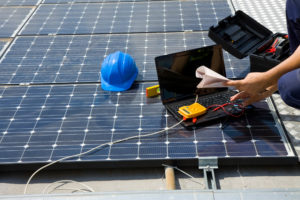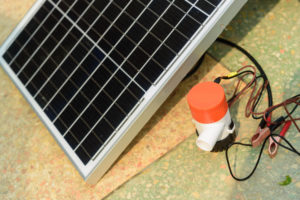You must’ve seen people installing solar panels on their rooftops and realizing a little too late that they are non-functional. It’s probably because they skipped out on testing their solar panels before installing them.
Switching to clean energy is a big decision that has a genuine impact on the environment. However, many people overlook the significance of testing their solar panels before installing them, even though it’s a very important step.
No one wants to be stuck with non-functional solar panels. Read this article to learn more about testing your panels to ensure that they are in good condition!
Contents
- 1 Key Takeaways
- 2 Why Should You Test Your Solar Panel?
- 3 What Should You Know Before Testing Solar Panels?
- 4 Where Do You Start With Testing Solar Panels?
- 5 Steps To Test Your Solar Panel
- 6 12 Volt Solar Panel vs. Other Voltages – Testing Differences
- 7 How Do You Test a Charge Controller?
- 8 Case Study: Ensuring Solar Panel Efficiency Through Pre-Installation Testing
- 9 Expert Insights From Our Solar Panel Installers About Testing Solar Panels
- 10 Experience Solar Excellence with Us!
- 11 Summing Up
Key Takeaways
- Solar panel testing is crucial before installation to ensure functionality, save costs, and optimize performance.
- Important prerequisites include knowing panel ratings, verifying sunlight conditions, and using a multimeter to measure output accurately.
- To test a solar panel, locate the converter box, identify positive and negative connections, set the multimeter appropriately, make connections with alligator clips, and check voltage readings for functionality. Testing the charge controller is also important to ensure efficient current flow.
Why Should You Test Your Solar Panel?
The primary goal of solar panel testing is to ensure that your panel system is fully functional before completing the installation process. It is possible that you will end up with a malfunctioning or non-functional solar panel after you install the structure.
Testing the panels will save you installation and removal costs. It will also guarantee optimization of performance, and your solar panel will work to its fullest potential.
The best solar panels have a high capacity factor. The average capacity factor hovers around 29%, but better panels can hit a maximum of 33%. By testing your solar panels, you will better understand your panel’s capacity factor and rate of efficiency after it has been installed.
A capacity factor of 18% or lower indicates that your solar panel is not up to the mark. Subjecting the panel to testing will serve as a means to understand whether your solar panel will work well after installation or not.
What Should You Know Before Testing Solar Panels?
Once you’ve decided to test out your solar panels before installing them, there are some things that you will need to keep in mind:
- Figure out the current and voltage ratings on the panel: You will most likely find these numbers behind the panel. Flip it around and make a note of the ratings.
- Verify sunlight conditions: Your solar panel serves no purpose if your sunlight conditions are inadequate. If the sun rays are weak or are not hitting the solar panels directly, the solar panel will not provide you with an accurate reading.
- Make the right connections: Ensure that the first thing you do is connect the regulator to the battery and then the regulator to the panel. If you want to disconnect the structure, first disconnect the panel from the regulator and then the regulator from the battery.
- Familiarize yourself with a multimeter: You will need to know the basics of how to use a multimeter to get an accurate reading of your solar panel output. Remember that you should not fully charge the battery since it will resist current under these conditions.

Where Do You Start With Testing Solar Panels?
Cross-check the list above and make sure that you meet all the pre-requisites. You can then familiarize yourself with the basic functioning of a solar panel so that you can test it accurately and gain a reliable reading.
Alternating Current and Direct Current
The primary difference between AC and DC is that DC flows in one direction and is associated with low voltage needs. Your solar panel runs on DC.
To calculate your solar panel’s output and power production, you need to measure both the wattage and voltage. This is the power that your panel is capable of producing.
Solar Panel Amperage
Ensure that your solar panel is given full sunlight and get your hands on an amp meter, a solar panel tester. To measure the amp output of the solar panel, make sure that the amp meter is attached to the positive and negative.
Measuring Current
For this step, you will need resistors and a multimeter, both of which will help you measure voltage.
The value for the current that you will get equals the voltage. This will give you an idea of your solar panel’s power-producing capabilities.
Steps To Test Your Solar Panel
You now know all the basics of how a solar panel functions and what you need to test it. Let us walk you through the steps of testing your solar panel to have a fully functioning clean energy system.
Find the converter box
Generally, the converter box is on the back of your solar panel. Flip your panel over and locate the converter box.
Once you have found it, remove the top. You will then see all the connections inside the converter box.
Locate the negative and positive connections
After you remove the top of the converter box, note where the negative and positive connections are located. Following this, tilt the panel in such a manner that it captures maximum sunlight on its surface.
Make sure that you set your multimeter to DC
You will have to ensure that your multimeter is set at a level higher than the volts that your solar panel is rated for. For instance, if 30 volts is the rating of your solar panel, the multimeter needs to be set to read higher than this.
Why do you need to set the multimeter at a higher level? This is the best way to guarantee an accurate and reliable reading. If you don’t know the solar panel rating, you will need to check the inside of the converter box. This is usually where the rating of your solar panel will be marked.
Make connections with alligator clips
You will see that your alligator clips are of two colors – black and red. The red-colored alligator clips will connect to the positive side that you would have noted earlier. The black-colored alligator will connect to the negative side.
Once you make these connections, your multimeter will give a reliable reading of the voltage that your solar panel can produce.
Remember that if your solar panel is new, it should give you a voltage reading that is very close to what it has been rated for.
For instance, if your panel is rated for 30 volts, and the multimeter gives you a reading that is equal to or very close to 30, it means that your panel is fully functional. On the other hand, if the voltage drops to 10, your solar panel may be a little old.
It is not uncommon to see used solar panels producing lower voltage readings on the multimeter. However, if your panel is new and doesn’t give you a reading that is close to what it has been rated for, we recommend that you get it checked by a professional.
New solar panels almost always provide readings that are equal to or at least similar to what they have been rated in the converter box.
Lastly, make sure that you switch off the multimeter completely before disconnecting the alligator clips from the converter box. This reduces the risk of any electrical harm or damage.

12 Volt Solar Panel vs. Other Voltages – Testing Differences
You will find that most solar panels have a rating of 12 volts. This means that the testing methods will remain the same for most solar panels.
One thing that you will have to ensure for all solar panels, regardless of the voltage ratings, is that positive-to-positive and negative-to-negative connections are between the multimeter and the solar panel.
It would be best if the multimeter is set to above 200VCD. This is most likely to yield an accurate reading for your solar panel. In case your multimeter is experiencing an overload, your VCD has been set too low. You will need to turn that up to gain an accurate reading.
Remember that all multimeters are made differently, and each one will vary slightly from the others. While they all serve the same purpose of giving you a solar panel reading, there are many different types that vary based on quality and price.
You will not face any difficulties with getting an accurate reading if your multimeter is fully functional. This is why it is important to look into the various multimeters available and buy the best one suited to your needs and requirements.
How Do You Test a Charge Controller?
As you go about testing your solar panel, it is equally important to test the charge controller. A charge controller test will ensure that sufficient current passes between the panel, controller, and battery.
There are a few simple steps you can follow to test your charge controller and make sure that it is working efficiently:
- Start with setting your multimeter to measure DC Amps.
- The leads need to be in the correct port to measure DC Amps accurately.
- Remove the positive wire that connects the battery to the controller. This disconnection process is crucial to test your charge controller.
- Next, take the positive lead from the multimeter and connect it to the positive cable that you just disconnected.
- Lastly, take the negative lead connected to the multimeter and connect it to the battery’s positive terminal.
If you follow these steps, you will find out if there is sufficient current passing through the solar panel, battery, and controller.
Case Study: Ensuring Solar Panel Efficiency Through Pre-Installation Testing
Background
At Solar Panels Network USA, we are dedicated to providing top-quality solar solutions that are both efficient and reliable. One of the most critical steps in our process is ensuring that every solar panel we install is thoroughly tested for functionality before it is mounted on a customer’s property.
Project Overview
A recent project involved a residential installation where the homeowner had purchased a new set of solar panels. Our task was to test these panels for efficiency and functionality before installation to ensure they met the performance standards and would provide the expected energy output.
Implementation
Pre-Installation Checklist
Before beginning the testing process, we conducted a comprehensive assessment of the customer’s requirements, including the total energy consumption and the available roof space. We also verified the current and voltage ratings of the panels and ensured optimal sunlight conditions for accurate testing.
Testing Process
- Identifying Panel Ratings: We first checked the back of each solar panel to note the current and voltage ratings.
- Sunlight Verification: Ensured the panels were exposed to direct sunlight for accurate readings.
- Using a Multimeter: Familiarized ourselves with the multimeter settings, setting it to a level higher than the panel’s rated voltage to ensure accuracy.
- Connecting Alligator Clips: Made precise connections using alligator clips, attaching the red clip to the positive terminal and the black clip to the negative terminal.
- Voltage Reading: Observed the voltage readings on the multimeter, comparing them to the rated values to confirm functionality.
Charge Controller Testing
In addition to testing the panels, we also tested the charge controller to ensure efficient current flow between the panel, controller, and battery. This involved:
- Setting the multimeter to measure DC Amps.
- Disconnecting the positive wire from the battery to the controller.
- Connecting the multimeter’s positive lead to the disconnected cable and the negative lead to the battery’s positive terminal.
Results
Through meticulous testing, we confirmed that all the solar panels were operating at their rated capacity. The voltage readings were consistent with the specifications, indicating that the panels were fully functional and ready for installation. The charge controller test also showed a smooth current flow, ensuring that the system would operate efficiently once installed.
Summary
Pre-installation testing of solar panels is crucial in guaranteeing optimal performance and longevity. By conducting thorough tests, we can ensure that each component of the solar energy system works as expected, providing reliable and efficient energy to our customers. Our commitment to quality and thoroughness in the testing phase helps build trust and satisfaction among our clients, ensuring they receive the best possible solar solutions for their needs.
Expert Insights From Our Solar Panel Installers About Testing Solar Panels
Testing solar panels before installation is essential to ensure they are functioning correctly. It can save you a lot of time and money in the long run by avoiding the need for reinstallation.
Senior Solar Installer
Accurate testing of solar panels involves understanding their voltage and current ratings and using a multimeter properly. It ensures the panels will perform as expected once installed.
Lead Solar Technician
Ensuring that solar panels are fully functional before installation is a critical step. It helps in achieving optimal performance and longevity for your solar energy system.
Solar System Engineer
Experience Solar Excellence with Us!
Trust in Solar Panels Network USA, where our seasoned experts deliver top-quality solar solutions for homes and businesses nationwide. With a legacy of countless successful installations and a commitment to sustainable energy, we’re your reliable partner in the solar journey. Ready for a brighter, eco-friendly future? Call us now at (855) 427-0058 and harness the power of the sun!
Summing Up
Testing is a necessary step that you will need to take to ensure the best performance from your solar panel. You may take the help of a professional solar company, if necessary, but make sure that you don’t skip testing your solar panel!
That’s everything you need to know about testing your solar panels before installing them! We hope that this article answered any questions you may have had about why testing solar panels is necessary and how to go about the process.
About the Author
Solar Panels Network USA stands at the forefront of solar energy solutions, driven by a team of seasoned solar engineers and energy consultants. With over decades of experience in delivering high-quality solar installations and maintenance, we are committed to promoting sustainable energy through customer-centric, tailored solutions. Our articles reflect this commitment, crafted collaboratively by experts to provide accurate, up-to-date insights into solar technology, ensuring our readers are well-informed and empowered in their solar energy decisions.

